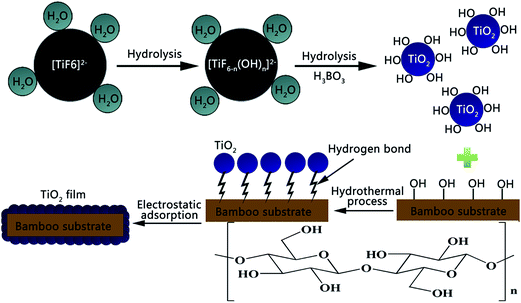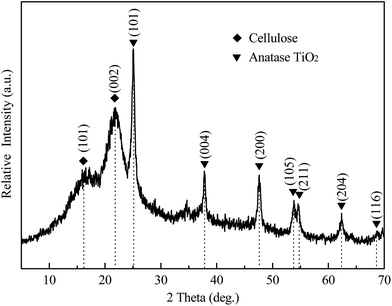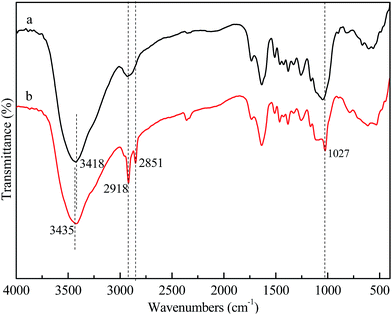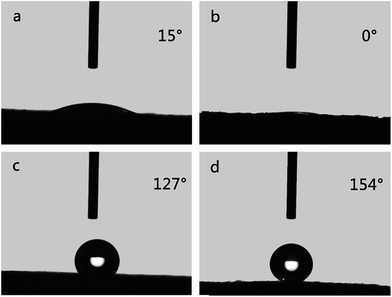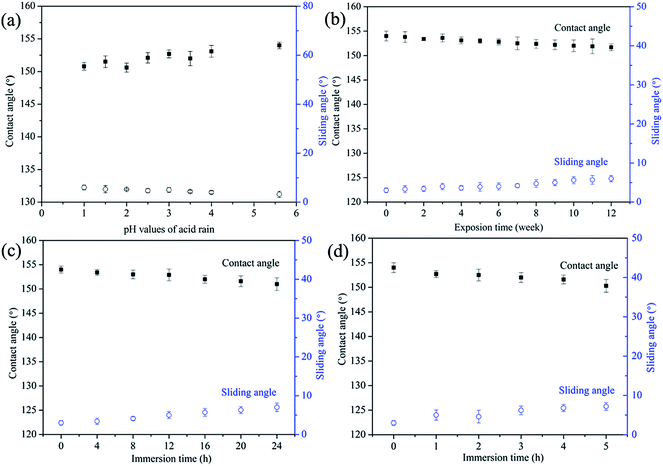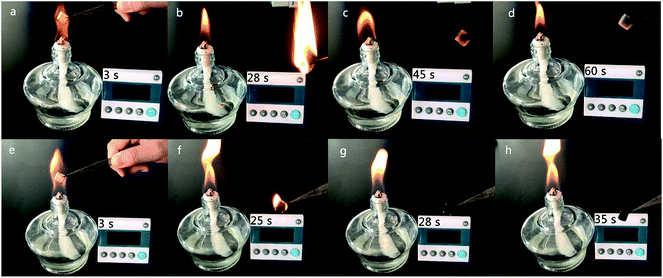Fabrication of superhydrophobic bamboo timber based on an anatase TiO2 film for acid rain protection and flame retardancy
Jingpeng Lia,
Huanhuan Zhenga,
Qingfeng Sun*ab,
Shenjie Hana,
Bitao Fana,
Qiufang Yaoa,
Chenye Yana and
Chunde Jin*ab
aSchool of Engineering, Zhejiang Agricultural and Forestry University, Lin’an 11300, PR China. E-mail: zafujincd@163.com; qfsun@zafu.edu.cn; Fax: +86-571-63732718; Tel: +86-571-63732718
bKey Laboratory of Wood Science and Technology, Zhejiang Province, PR China
First published on 8th July 2015
Abstract
A facile method for fabricating superhydrophobic bamboo timber based on an anatase TiO2 film for acid rain protection and flame retardancy is described in the present work. Bamboo timber with a maximal water contact angle of 154° has been prepared by the hydrothermal deposition of anatase TiO2 nanoparticles and further modified with octadecyltrichlorosilane (OTS). The geometric microstructure of the anatase TiO2 nanoparticles and the chemical composition of the superhydrophobic coating were analyzed by scanning electron microscopy (SEM), energy dispersive X-ray spectroscopy (EDX), X-ray diffraction (XRD), Fourier transform infrared spectroscopy (FTIR) and thermogravimetric analysis (TGA). The wetting behavior of the bamboo timber samples was investigated by water contact angle (WCA) measurements. The results indicated that strong hydrogen bonds were formed between the amorphous TiO2 and the hydroxide radicals of the bamboo timber surfaces, and the strong interaction contributed to the heat stability enhancement of the TiO2/bamboo timber composites. Moreover, the diverse performance of the superhydrophobic bamboo timber has been evaluated as well. The treated bamboo timber exhibited outstanding superhydrophobicity, excellent waterproofing durability, acid rain resistance, and flame retardancy, offering a potential opportunity to accelerate the large-scale production of superhydrophobic woody material for new industrial applications.
1. Introduction
Bamboo is a type of biomass material and has been widely cultivated in the west and south of China.1 Bamboo resources are very abundant and will become one of largest potential bio-energy resources of the future in China.2 At present, the area of bamboo in China is about 5 million ha. Bamboo is a favored material due to its fast growth and a general shortage of wood supplies. In 3–5 years, the mechanical strength, utilization properties, and anatomical characteristics of bamboo become stable and mature, making it suitable for various uses.3 In general, bamboo is widely used in traditional applications, such as flooring, furniture, construction, pulping, scaffolding, and handcrafts.4,5 With the development of adhesive bonding and the processing technology, strand woven outdoor flooring has drawn the attention of more and more companies in China, and the products are popular in the United States, Europe, Southeast Asia, and so on.6 However, when exposed in an outdoor environment, bamboo shows bad decay-resistance without a protective treatment and can be attacked by fungi and insects and degraded by moisture, air, fire, acid rain, and sunlight, which largely shortens its service life and also reduces its value.7,8Bamboo stem is composed of three parts: bamboo skin, bamboo timber, and pith.9 The bamboo skin is the outermost thin layer of the cross section of the stem wall, where no vascular bundles are present. The pith is the part of stem wall next to the bamboo cavity; it also does not have vascular bundles. The bamboo timber is the part between the skin and pith. Vascular bundles are visible across the timber section. The density of the vascular bundles decreases from the outer side of the stem wall to the inner side. The bamboo timber can be further divided into three layers. The outer part where the vascular bundles are dense is called bamboo green, while the inner part where the vascular bundles are rare is called bamboo yellow. The layer between bamboo green and yellow is called bamboo timber. If not indicated otherwise, the term “bamboo timber” in this study means the layer between bamboo green and bamboo yellow (Fig. 1).
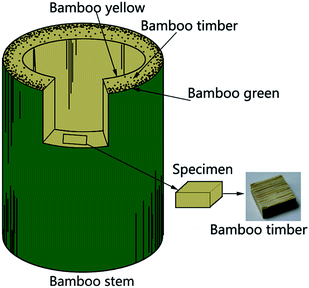 | ||
| Fig. 1 Schematic diagram of the three layers (bamboo green, bamboo timber and bamboo yellow) of bamboo. | ||
To protect bamboo and enhance the economic value of bamboo products, it is necessary to develop a protective treatment for bamboo materials. In previous studies, Yu et al.10,11 have demonstrated that bamboo can be simultaneously functionalized with photostability and antifungal and antibacterial properties by being coated with nanostructured ZnO. Sun et al.6 proved that bamboo treated with a chitosan–copper complex had better resistance against mould and fungi. In our early reports, a bamboo substrate treated with ZnO nanostructures and subsequently modified with fluoroalkylsilane exhibited not only robust superhydrophobicity but also superior water-resistance, UV-resistance, and fire-resistance.12 At present, hybrid bamboo/inorganic composites fall under the category of new functional nanocomposite materials. Synergistic effects resulting from physical or chemical interactions between the inorganics and the bamboo components play a vital role in various properties, such as improved thermal, mechanical, and dimensional stability. Nano-sized particles of inorganic materials, such as TiO2,13 ZnO,14 SiO2,15 CuO,16 and Ag,17 are very useful due to their outstanding properties and potential applications. Especially TiO2, apart from having wide applications for photocatalysis, solar cells, paints, etc., it also has been used with wood to improve the fire-resistance, antifungal, and aging durability properties.18–21 To the best of our knowledge, there are few reports about the production of TiO2 films on bamboo substrates by a hydrothermal method. This study is aimed at investigating strategies to generate TiO2 on the bamboo substrate surfaces and to further develop a protective treatment for bamboo substrates.
As we all know, the acid rain resistance, thermal stability and flame retardancy of superhydrophobic materials play pivotal roles in their practical applications, however, not enough attention to these properties has been given. Therefore, in this work, we successfully fabricated a bamboo timber with the important functions of superhydrophobicity, acid rain resistance, and flame retardancy by the hydrothermal deposition of anatase TiO2 nanoparticles to increase the surface roughness, followed by hydrophobization with OTS. Compared with traditional approaches, this method is simple and the procedure is convenient to operate. The static WCA of the superhydrophobic sample was 154° with a droplet volume of 5 μL. Moreover, the diverse performance of superhydrophobic bamboo timber has been evaluated. The acid rain resistance and flame retardancy of the superhydrophobic bamboo timber were also studied.
2. Materials and methods
2.1. Materials
All chemicals were supplied by Shanghai Boyle Chemical Company Limited and used as received. Moso bamboo slices (L × T × R) of 20 mm × 20 mm × 4 mm were ultrasonically rinsed in deionized water, washed with acetone for 30 min, and then they were completely dried in the oven at 60 °C for 24 h.2.2. Fabrication of anatase TiO2 nanoparticles on the surface of the bamboo timber via a hydrothermal method
Ammonium fluorotitanate (4.0 g) and boric acid (3.7 M) were dissolved in distilled water in a 100 mL glass container at room temperature under vigorous magnetic stirring. Then, 1.0% hydrochloric acid aqueous solution was added drop by drop until the pH reached approximately 3. Then, 75 mL of the adjusted solution was transferred into a 100 mL Teflon container. Bamboo specimens were subsequently placed into the above reaction solution, separately. The autoclave was sealed and maintained at 85 °C for 5 h, then cooled to room temperature naturally. Finally, the prepared samples were removed from the solution, ultrasonically rinsed with anhydrous ethanol for 15 min, and dried at 60 °C for more than 24 h in a vacuum oven.2.3. Fabrication of superhydrophobic bamboo timber
In order to reduce the surface energy of the bamboo substrate, the surfaces of the as-prepared samples were chemically modified with octadecyltrichlorosilane (OTS). OTS was used to hydrophobize the bamboo timber according to the report by Wang et al.22 The bamboo timber with a layer of TiO2 nanoparticles was fluorinated in the solution of OTS (1%, v/v, in anhydrous ethanol) at ambient temperature for 5 h, followed by rinsing with ethanol and drying in a vacuum oven.2.4. Characterization
The morphology of the samples was observed using scanning electron microscopy (SEM, FEI, Quanta 200). The chemical compositions of the untreated and treated wood were measured by energy dispersive spectroscopy (EDS, attached to the SEM). The crystalline structures were identified by X-ray diffraction (XRD, Rigaku, D/MAX 2200) operating with Cu Kα radiation (λ = 1.5418 Å) at a scan rate (2θ) of 4° min−1 with an accelerating voltage of 40 kV and an applied current of 30 mA ranging from 5° to 70°. FTIR spectra for the bamboo samples were recorded using FTIR (Magna-IR 560, Nicolet). The contact angle was measured on an OCA40 contact angle system (Dataphysics, Germany) at room temperature with a droplet volume of 5 μL. An average of five measurements taken at different positions on each sample was used to calculate the final CA. Thermogravimetric and differential thermal analyses were performed using a PE-TGA7 thermogravimetric analyzer (Perkin Elmer Company) and a DTA/9050311 high temperature differential analyzer. 10 mg of the samples were taken and measured in air, and then treated in 150 mL min−1 of dry pure N2 with temperatures ranging from 25 °C to 700 °C at a rate of 10 °C min−1.3. Results and discussion
3.1. Synthesis of the anatase TiO2 films on the surface of bamboo timber
The anatase TiO2 films were formed on the surface of the bamboo timber by a hydrothermal process containing the hydrolysis of (NH4)2TiF6 and the condensation of hydrolyzed titanium species. The initial precursor solution and the original bamboo with hydroxyl groups on its surface are shown in Fig. 2. The initial solution contains numerous [TiF6]2− ions, H+ ions, and H2O molecules. The main reaction equilibrium equations in the mixed solution are as follows:23–25 eqn (1) is the hydrolyzation of [TiF6]2− ions; eqn (2) is the reaction between H3BO3 and the F− ions produced in eqn (1), the F− ions are consumed through eqn (2), leading to the chemical equilibrium in eqn (1) shifting from left to right; eqn (3) is the further hydrolyzation of [TiF6−n(OH)n]2− ions. With the addition of HCl, the increased H+ ions in the solution accelerate eqn (2) to move forward. In addition, there are abundant hydroxyl groups on the bamboo surface. The obtained [TiF6−n(OH)n]2− ions hydrolyzed gradually to generate nano-TiO2 with the participation of the hydrothermal energy, and then the resulting nano-TiO2 formed strong interactions with the hydroxyl groups of the bamboo surface, contributing to the deposition and stabilization of TiO2 nanoparticles on the bamboo substrate.26 Subsequently, TiO2 nanoparticles were attracted and combined with the previous TiO2 due to the electrostatic adsorption force, resulting in a multilayer of TiO2 nanoparticles on the bamboo surface.| [TiF6]2− + nH2O → [TiF6−n(OH)n]2− + nH+ + nF− (n = 0–6) | (1) |
| H3BO3 + 4HF → HBF4 + 3H2O | (2) |
| [TiF6−n(OH)n]2− + (2 − n)H2O → TiO2 + (4 − n)H+ + (6 − n)F− | (3) |
3.2. Studies of the surface morphology and composition
Fig. 3 shows the surface morphology of the original bamboo and the TiO2-treated bamboo at low and high magnification. As shown in Fig. 3a, the microstructures of the original bamboo, including some pits, can be obviously observed. The inset in Fig. 3a gives a typical EDS spectrum of the chemical composition of the original bamboo. Only C, Au, and O elements could be detected from the spectrum. The element Au originates from the coating layer used for the SEM observation and the C and O elements are from the bamboo substrate. In Fig. 3b, the original bamboo surface is covered by a dense and even film of TiO2 microparticles. These bright points were subsequently proven to be TiO2 nanofilms by EDS because of the strong Ti peaks (Fig. 3b, inset). No other elements were detected, thus confirming that the composition of the microspheres is TiO2. Fig. 3c presents a SEM image of TiO2-treated bamboo under higher magnification. Clearly, the bamboo surface is covered by plenty of irregularly shaped TiO2 aggregations and forms a nanoscale roughness on the bamboo surface. | ||
| Fig. 3 SEM images of (a) an original bamboo timber and a bamboo timber decorated with TiO2 coating at (b) low and (c) high magnification. | ||
To identify the purity of the TiO2 coated on the surface of the bamboo timber, XRD was performed. Fig. 4 displays the XRD pattern of the bamboo timber samples coated with TiO2. According to Fig. 4, the characteristic peaks at 16° and 22° are assigned to the crystalline region of cellulose in the original bamboo timber.2 Some new strong diffraction peaks at 25.3°, 37.8°, 48.0°, 54.2°, and 62.5° correspond to the (101), (004), (200), (105), and (204) planes of the anatase TiO2 crystals (JCPDS cards: 21-1272), respectively. Moreover, no characteristic peaks were observed from other impurities, indicating the purity of the anatase TiO2 coating.
OTS is a widely used self-assembled monolayer molecule used to lower surface energies in various applications. Previous studies have shown that the OTS molecules in the organic solvent can be gradually adsorbed onto a water layer present on TiO2. Following physisorption, the trichlorosilane head groups are hydrolyzed to form trisilanols. Recently, Lee et al.27 proved that the silanols exist in a highly mobile hydrogen-bonded state. This leads to an important in-plane reorganization of the OTS molecules, thereby forming a uniform densely packed molecular island at the early stage of monolayer formation on the TiO2 substrate. The silanol head groups of this island then become grafted to the TiO2 substrate by irreversible cross-linking to one another and covalent grafting to the substrate surface. FTIR characterization was employed to testify the existence of the OTS molecules on the superhydrophobic surface. The FTIR spectra of the original bamboo timber and the superhydrophobic films in the range of 4000–400 cm−1 are displayed in Fig. 5. In the high frequency region, the band at 3418 cm−1 (stretching vibrations of OH groups) (Fig. 5a) shifted to 3435 cm−1 (Fig. 5b) and has a lower intensity, indicating that the hydrophilic OH groups are consumed by the OTS coating.28 The spectra of the superhydrophobic surface exhibited adsorption peaks at about 2918 cm−1 and 2851 cm−1, which were attributed to C–H asymmetric and symmetric stretching vibrations, respectively.22 In the low frequency region, the spectra of the TiO2 and OTS modified bamboo timber showed peaks at 1027 cm−1 resulting from the Si–O–Si bending vibrations.29,30 Thus, we could deduce that the OTS molecules had combined with the TiO2 films on the surface of the bamboo timber. The FTIR absorption band assignment of the superhydrophobic surface is described in Table 1.
| Band position (cm−1) | Assignment |
|---|---|
| 3435 cm−1 | –OH groups |
| 2918 cm−1 and 2851 cm−1 | C–H asymmetric and symmetric stretching vibrations |
| 1027 cm−1 | Si–O–Si bending vibrations |
3.3. Surface wettability
Fig. 6 shows photographs of water droplets on the surface of the pristine bamboo timber, the bamboo timber decorated with TiO2 films, the bamboo timber modified with OTS monolayer, and the superhydrophobic bamboo timber. It obviously demonstrates that bamboo timber is a type of hydrophilic material and shows a contact angle of 15°. The water droplet immediately spread out on the surface of the bamboo timber covered with the TiO2 films and the WCA was nearly 0°, which is attributed to the presence of OH groups on the surface of the TiO2 films. On the contrary, the bamboo timber modified by OTS could achieve a maximal WCA of about 127° and shows a hydrophobic property, to a certain extent. But after the deposition of TiO2 films by a self-assembly of the OTS monolayer, the surface of the bamboo timber exhibited an excellent hydrophobic property. During this process, the surface of the bamboo timber transformed from hydrophilic to superhydrophobic: the WCA reached a maximum of 154°, and the sliding angle was about 4°. In conclusion, with the combination of TiO2 films creating high surface roughness and the OTS monolayer lowering the surface energy, a large amount of air is trapped into the interspaces or cavities of the superhydrophobic bamboo timber, and the water droplet is primarily connected with the trapped air.17 Therefore, the treated bamboo timber cannot be wetted by a water droplet and presents superhydrophobicity.3.4. Acid rain resistance and stability evaluation
The acid rain resistance of the superhydrophobic bamboo timber is an extremely important aspect that needs to be investigated for practical applications. In order to evaluate the acid rain resistance of the superhydrophobic bamboo timber, the obtained superhydrophobic bamboo timber was immersed in simulated sulfuric acid rain (pH = 1.0, 1.5, 2.0, 2.5, 3.0, 3.5, and 4.0) and a control rain (pH = 5.6) for 12 h. The relationship between the pH value of the acid rain and the CAs on the treated bamboo timber samples is demonstrated in Fig. 7a. The pH value of the acid rain was adjusted by sulfuric acid. The resulting surface retains superhydrophobicity after immersion in the simulated sulfuric acid rain for 12 h, which suggests that the acquired superhydrophobic surface has good chemical stability in an acid rain environment.The long-term stability also plays a vital role in determining the feasibility of the superhydrophobic surface in industrial applications. In this work, the effects of the exposure time to air, the immersion time in the 5.0 wt% NaCl solution, and the immersion time in alkali (pH = 12) solutions on the wettability of the superhydrophobic surface were examined. Fig. 7b shows the variations of the CAs and the SAs of the superhydrophobic surface according to the exposure time to air. Both the CAs and SAs change slightly during air exposure for 12 weeks, which indicates that the superhydrophobic surface has good long-term stability in air. The changes of the CAs and SAs with increasing immersion time in the 5.0 wt% NaCl solution are shown in Fig. 7c. The CAs gradually decrease and the SAs gradually increase with the increase in immersion time. The CA of 151° and the sliding angle of 7° are still maintained after immersion in the solution for 24 h, suggesting that the long-time immersion in the 5.0 wt% NaCl solution does not have a great influence on the superhydrophobicity of the surface. Fig. 7d displays the variation of the CAs with immersion time in alkali (pH = 12) solutions. The pH value was adjusted by sodium hydroxide. After being placed into a sodium hydroxide solution of pH 12 for 5 h at room temperature, the bamboo surface still maintained its superhydrophobic property and the CAs were larger than 150°. As a result, the superhydrophobic surface has long-term stability in air and 5.0 wt% NaCl solution. It also displays good chemical stability in an alkaline environment.
3.5. Thermal stability and flammability
The TG and DTG curves of the pristine bamboo timber, the TiO2 treated bamboo timber, and the bamboo timber treated by TiO2 and OTS are shown in Fig. 8. According to the TG curve (Fig. 8), there is a small weight loss in the range from 50 to 90 °C because of the removal of the residual water before pyrolysis.31 Three stages of the thermal degradation of the pristine bamboo timber were clearly visible.32 At stage one (190–250 °C), the pyrolysis rate was low with a weight loss of approximately 11.2%, which is mainly attributed to the partial degradation of hemicellulose. Stage two (250–380 °C) was mainly caused by cellulose degradation, accompanied with the continuous degradation of lignin, whose maximum pyrolysis rate occurred at 339 °C and the weight loss reached 61.4%. At stage three (380–700 °C), all the components of the bamboo timber degraded gradually, leading to aromatization and carbonization. The lignin was difficult to decompose. Its decomposition happened slowly and continued during the whole calcining process.33 At last, carbon residues with a weight of 26.1% were left, as observed from the TG curve (Fig. 8a). The DTG curve shows that the first decomposition shoulder peak at about 293 °C is attributed to the thermal depolymerisation of hemicellulose, and the major second decomposition peak at about 339 °C is caused by the cellulose decomposition. Similar to the bamboo timber with or without treatment with TiO2, the bamboo timber treated by TiO2 and OTS also shows three stages of pyrolysis. However, the DTG curve (Fig. 8b and c) shows strong and sharp endothermic peaks at a minimum of 359 °C for the TiO2 treated bamboo timber and 362 °C for the bamboo timber treated by TiO2 and OTS, corresponding to the weight losses in the TG curve. The maximum degradation rates of the TiO2-treated bamboo timber and the bamboo timber treated by TiO2 and OTS shifted to larger than the pristine bamboo timber, which may be attributed to the protection of the TiO2 and the OTS which, as a barrier, effectively protected the bamboo timber. These results imply that the thermal stability of the treated bamboo timber was higher than that of the pristine bamboo timber due to the strong interaction between the bamboo timber and TiO2.34,35 The computed weight losses during the whole process were about 73.9% for pristine bamboo timber, 71.8% for the TiO2 treated bamboo timber, and 76.3% for bamboo timber treated by TiO2 and OTS.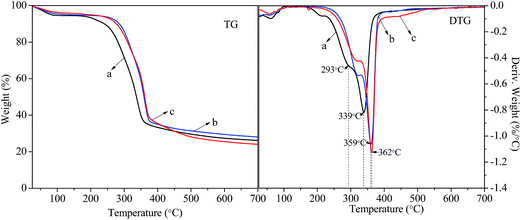 | ||
| Fig. 8 Thermal analysis (TG/DTG) profiles of (a) the original bamboo timber, (b) the TiO2-treated bamboo timber, and (c) the bamboo timber modified by TiO2 and OTS. | ||
As demonstrated and mentioned above, an efficient method to enhance the flame retardancy of synthetic and natural cellulose-based substrates is by adding the inorganic particles to the finishing formula.36–38 The inorganic nano-coating on the surface modifies the combustion behavior of the cellulose-based substrates by decreasing the total heat release, the mass loss rate, and the effective heat of combustion. It has been verified that the inorganic nano-coating is able to protect the polymer from transferring oxygen and heat, thus blocking its decomposition. The inorganic nano-coating can also delay the ignition of the sample.32,39
In order to describe a realistic fire scenario, it is necessary to test the ignitability of the pristine bamboo timber and the superhydrophobic bamboo timber in the presence of a flame. Interestingly, the superhydrophobic bamboo timber exhibits excellent fire-resistance when exposed to the flame of an alcohol burner. Fig. 9 shows digital photos of the pristine bamboo timber and the superhydrophobic bamboo timber burning on the alcohol burner. When heated with the alcohol burner, the pristine bamboo timber caught fire at 3 s and was incinerated to ash in 60 s (Fig. 9a–d). Being burned for 28 s (Fig. 9b), the pristine bamboo timber had a massive blaze. In the following 32 seconds, the strong flames gradually diminished (Fig. 9c), but the fire still spread (Fig. 9d). By contrast, being burned for 28 s (Fig. 9g), the superhydrophobic bamboo timber was not covered with flames. Furthermore, the flame gradually quenched itself in the following 7 s seconds (Fig. 9h). After combustion, black char was left. Apparently, the superhydrophobic bamboo timber is more suitable than the pristine bamboo timber, thus it provides a potential application for functional and building materials.
4. Conclusions
In summary, we have reported a simple and facile method for fabricating bamboo timber with some functions of superhydrophobicity, acid rain resistance and flame retardancy. Anatase TiO2 films deposited on the surface of the bamboo timber with the participation of hydrothermal energy and electrostatic adherence improved the thermal stability of the TiO2/bamboo timber composites because of the plentiful hydrogen bonds with the hydroxide radicals of the bamboo timber surface. The wetting behavior of the samples after hydrothermal deposition and further decoration transformed from hydrophilicity to superhydrophobicity with a maximum WCA of 154°. Importantly, the investigation results also demonstrate the excellent waterproofing durability, acid rain resistance, and flame retardancy of the modified bamboo timber, which offers an opportunity to facilitate the development of superhydrophobic woody materials for new practical purposes.Acknowledgements
The work was financially supported by the National Natural Science Foundation of China (31470586), the Pre-research Project of Research Center of Biomass Resource Utilization of Zhejiang A & F University (2013SWZ01-03), and the Scientific Research Foundation of Zhejiang A&F University (Grant No. 2014FR077).References
- N. Chand, D. Jain and A. Nigrawal, J. Appl. Polym. Sci., 2006, 102, 380–386 CrossRef CAS PubMed.
- J. Li, Q. Sun, C. Jin and J. Li, Ceram. Int., 2015, 41, 921–929 CrossRef CAS PubMed.
- C. Jin, J. Li, J. Wang, S. Han, Z. Wang and Q. Sun, J. Nanomater., 2014, 2014, 3 Search PubMed.
- K. Chung and W. Yu, Eng. Struct., 2002, 24, 429–442 CrossRef.
- W. Zhang, Y. He, M. Zhang, Z. Yin and Q. Chen, J. Phys. D: Appl. Phys., 2000, 33, 912 CrossRef CAS.
- F. Sun, B. Bao, L. Ma, A. Chen and X. Duan, J. Wood Sci., 2012, 58, 51–56 CrossRef CAS.
- K.-C. Hung, Y.-L. Chen and J.-H. Wu, Polym. Degrad. Stab., 2012, 97, 1680–1685 CrossRef CAS PubMed.
- K.-T. Lu, J. Wood Sci., 2006, 52, 173–178 CrossRef CAS.
- Z. Li, Z. Jiang, B. Fei, Z. Cai and X. Pan, Bioresour. Technol., 2014, 151, 91–99 CrossRef CAS PubMed.
- Y. Yu, Z. Jiang, G. Wang, G. Tian, H. Wang and Y. Song, Wood Sci. Technol., 2012, 46, 781–790 CrossRef CAS.
- Y. Yu, Z. Jiang, G. Tian, H. Wang and Y. Song, Wood Fiber Sci., 2011, 43, 293–304 CAS.
- C. Jin, J. Li, S. Han, J. Wang and Q. Sun, Appl. Surf. Sci., 2014, 320, 322–327 CrossRef CAS PubMed.
- H. Irie, Y. Watanabe and K. Hashimoto, Chem. Lett., 2003, 32, 772–773 CrossRef CAS.
- X. Feng, L. Feng, M. Jin, J. Zhai, L. Jiang and D. Zhu, J. Am. Chem. Soc., 2004, 126, 62–63 CrossRef CAS PubMed.
- C. Mai and H. Militz, Wood Sci. Technol., 2004, 37, 453–461 CrossRef CAS.
- S. Ko, J. I. Lee, H. S. Yang, S. Park and U. Jeong, Adv. Mater., 2012, 24, 4451–4456 CrossRef CAS PubMed.
- C. Jin, J. Li, S. Han, J. Wang, Q. Yao and Q. Sun, J. Alloys Compd., 2015, 635, 300–306 CrossRef CAS PubMed.
- L. Gao, Y. Lu, X. Zhan, J. Li and Q. Sun, Surf. Coat. Technol., 2015, 262, 33–39 CrossRef CAS PubMed.
- F. Chen, X. Yang and Q. Wu, Build. Environ., 2009, 44, 1088–1093 CrossRef PubMed.
- H. Miyafuji and S. Saka, Wood Sci. Technol., 1997, 31, 449–455 CAS.
- M. S. Mahr, T. Hübert, M. Sabel, B. Schartel, H. Bahr and H. Militz, J. Mater. Sci., 2012, 47, 6849–6861 CrossRef.
- S. Wang, C. Wang, C. Liu, M. Zhang, H. Ma and J. Li, Colloids Surf., A, 2012, 403, 29–34 CrossRef CAS PubMed.
- A. A. Umar, S. Nafisah, S. K. M. Saad, S. T. Tan, A. Balouch, M. M. Salleh and M. Oyama, Sol. Energy Mater. Sol. Cells, 2014, 122, 174–182 CrossRef PubMed.
- J. Tao, J. Zhao, X. Wang, Y. Kang and Y. Li, Electrochem. Commun., 2008, 10, 1161–1163 CrossRef CAS PubMed.
- L. Gao, X. Zhan, Y. Lu, J. Li and Q. Sun, Mater. Lett., 2015, 142, 217–220 CrossRef CAS PubMed.
- C. Wan, Y. Lu, Q. Sun and J. Li, Appl. Surf. Sci., 2014, 321, 38–42 CrossRef CAS PubMed.
- J. Lee, H. Kim, C. Park, G. Park, H. Kwak, S. Koo and M. Sung, J. Phys. Chem. B, 2003, 107, 8997–9002 CrossRef CAS.
- C. Wang, M. Zhang, Y. Xu, S. Wang, F. Liu, M. Ma, D. Zang and Z. Gao, Adv. Powder Technol., 2014, 25, 530–535 CrossRef CAS PubMed.
- S. Wang, R. Mahlberg, O.-V. Kaukoniemi, J. Nikkola, J. Mannila, S. Jämsä, A.-C. Ritschkoff and J. Peltonen, Appl. Surf. Sci., 2012, 258, 4678–4686 CrossRef CAS PubMed.
- C. Liu, S. Wang, J. Shi and C. Wang, Appl. Surf. Sci., 2011, 258, 761–765 CrossRef CAS PubMed.
- E. Ahmad and A. Luyt, Composites, Part A, 2012, 43, 703–710 CrossRef CAS PubMed.
- J. Li, Q. Sun, Q. Yao, J. Wang, S. Han and C. Jin, J. Nanomater., 2014 DOI:10.1155/2014/687350.
- H. Yang, R. Yan, H. Chen, D. H. Lee and C. Zheng, Fuel, 2007, 86, 1781–1788 CrossRef CAS PubMed.
- L. Haurie, A. I. Fernández, J. I. Velasco, J. M. Chimenos, J.-M. L. Cuesta and F. Espiell, Polym. Degrad. Stab., 2007, 92, 1082–1087 CrossRef CAS PubMed.
- R. Valiokas, M. Östblom, S. Svedhem, S. C. Svensson and B. Liedberg, J. Phys. Chem. B, 2002, 106, 10401–10409 CrossRef CAS.
- A. L. Mohamed, M. A. El-Sheikh and A. I. Waly, Carbohydr. Polym., 2014, 102, 727–737 CrossRef CAS PubMed.
- S. Hribernik, M. S. Smole, K. S. Kleinschek, M. Bele, J. Jamnik and M. Gaberscek, Polym. Degrad. Stab., 2007, 92, 1957–1965 CrossRef CAS PubMed.
- J. Alongi, M. Ciobanu and G. Malucelli, Carbohydr. Polym., 2012, 87, 2093–2099 CrossRef CAS PubMed.
- J. Alongi, M. Ciobanu and G. Malucelli, Carbohydr. Polym., 2011, 85, 599–608 CrossRef CAS PubMed.
| This journal is © The Royal Society of Chemistry 2015 |

